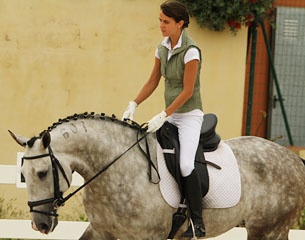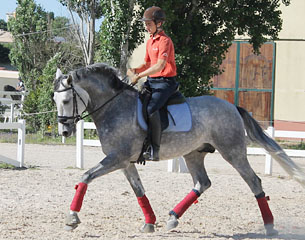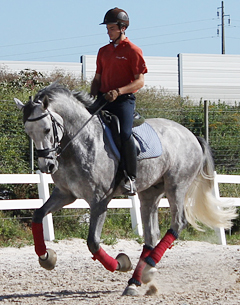
I have interviewed many of the world's top dressage riders and am often curious as to how they structure a training session for their horse. Typically, when asked the question, they will say, "well, I warm up for X amount of time, and then I begin schooling the exercises, etc."
Regardless of how long they spend in "warm-up" phase, this answer does not properly explain what they do during this time.
Why do they do it for the specified time? How do they know when their horse is warmed-up? And when did they come to accept this method, and time period as an acceptable means of preparing the horse for the lesson?
On a young horse, I find the term "warm-Up" particularly confusing, as really isn't his entire training schedule based on warming him up for the future? The warm-up on a young horse effectively becomes the work and the cooling down a reversal of the way you initiated the lesson. In addition, warming up a horse not only depends on their age, but also on their physical fitness, overall mental willingness, current mental status, the weather, physical weaknesses, physical strengths, and of course your own physical and mental capabilities on any given day. So it would seem very clear that there is no one way to warm-up a horse, but there are certain guidelines and goals one should aim for each and every time you take up the reins.
First walk. Everyone says you should try to walk your horse out loose for at least ten minutes at the start of each lesson and this is true. However if your horse is having a particularly fiery day for some particular reason, your warm-up may be better (or more safely achieved) in a lunging arena!
Once you have walked for the ten minutes, I usually begin with relaxed walk- halt -walk transitions, making sure I have the horse's attention and sensitivity to my aids before going to trot. This also helps me determine how the lesson will go; if I can use today as a day for training the more difficult movements or if he is off with the fairies. Then the time would be better spent working on the foundations: rhythm, relaxation, balance, suppleness, responsiveness, cadence!
Once I feel confident he is listening to my seat, I begin in a slow trot, a normal trot, not asking for length or cadence, but just focusing on rhythm and looseness.
 Mariette Withages says the horse should end the warm-up feeling like a "wobbly pudding" so the aim from the minute you begin the trot should be to relax every muscle in his body and gradually allow him to stretch more and more into a light contact, where your hands merely act to guide him on a large even circle.
Mariette Withages says the horse should end the warm-up feeling like a "wobbly pudding" so the aim from the minute you begin the trot should be to relax every muscle in his body and gradually allow him to stretch more and more into a light contact, where your hands merely act to guide him on a large even circle.
From there you begin to change the rein, ensuring the balance stays centred as you make the change. Do not allow the horse to quicken the tempo, or turn in onto your leg as you make the swap to the other side. You cannot establish true looseness until you have correct balance, because otherwise the horse's weight will not be at equilibrium and he can never fully relax all his muscles evenly.
Once you can move from one diagonal onto the other, without any change at all in the trot, you can begin transitions within the trot, going on and coming back, slowly engaging him more and more, and subtley asking for more impulsion without actually having to ask! Someone on the ground may not even see the difference, the change in the trot should be slight, but just enough so you can feel the horse's muscles working, lengthening the stride for 8 steps and then engaging himself again underneath you. This way he will actually lift himself up into a higher frame and gradually you will achieve more collection and cadence without having to pull his head off!
When you feel he is relaxed, responding to your seat, and beginning to find more impulsion you can warm-up the canter. Striking off from the trot, ensure you have enough bend to the inside, that you can make the transition without him coming up but still maintaining a light contact and a long loose neck. Then canter on a big circle and again start the going on and coming back transitions, ensuring he is listening and engaging but remaining in a warm-Up frame. This means his head should be stretched out and his gullet as open as you can get it, while still remaining round and working over the back.
 Once the canter feels loose and open, come back to trot and perhaps start some trot-canter, trot-walk transitions, still on a long rein, to further engage the horse and again generate more impulsion from behind. By this time you can well and truly tell how the horse is feeling today. If he feels loose, swinging, responsive, powerful, engaged, and ready to work, then continue with transitions and gradually lift him up into collection and work on the more advanced movements, or train for the test, but be specific. Don't train a bit of everything half-heartedly. Decide what it is you want to achieve and achieve it!!
Once the canter feels loose and open, come back to trot and perhaps start some trot-canter, trot-walk transitions, still on a long rein, to further engage the horse and again generate more impulsion from behind. By this time you can well and truly tell how the horse is feeling today. If he feels loose, swinging, responsive, powerful, engaged, and ready to work, then continue with transitions and gradually lift him up into collection and work on the more advanced movements, or train for the test, but be specific. Don't train a bit of everything half-heartedly. Decide what it is you want to achieve and achieve it!!
If you decide you want to get a perfect, forward, correct shoulder-in, it may take you two go's and you get it, so don't go over it and don't try something else, reward, stretch, and go for a walk out! If you can't get it, work different exercises that may improve your ability to achieve said task and then go back to it, until you get it! It may take 40 minutes of bending, transitions and vaults, until you can get the shoulder-in you want, but don't go home until you feel satisfied that you have at least improved the shoulder-in, or improved the shoulder-in preparation exercises, before you give up!
When you have accomplished said objective, it's back to a reverse of what you did to begin, like unwinding a clock the exact opposite way to how you wound it up! So begin transitions, going on and coming back, gently letting the horse out into a stretching loose frame and let this stretch go into all the paces, flowing forward in a big bold canter and then slowing to a rhythmical relaxed trot with only the slightest contact on the tip of your little finger!
The horse should feel again like a big wobbly pudding, this time a little less eager, but even more relaxed and accepting and with any luck satisfied with the day's work!
by Sarah Warne
Photos © Pedro Yglesias de Oliveira
Related Links
Classical Training with Sarah Warne